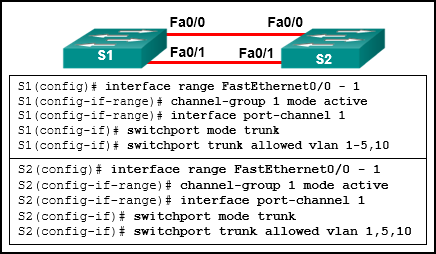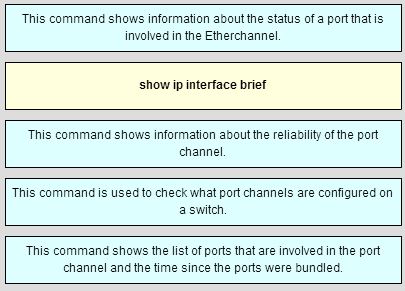Last Updated on April 24, 2018 by Admin
CCNA 3 Chapter 3
From year to year, Cisco has updated many versions with difference questions. The latest version is version 6.0 in 2018. What is your version? It depends on your instructor creating your class. We recommend you to go thought all version if you are not clear. While you take online test with netacad.com, You may get random questions from all version. Each version have 1 to 10 different questions or more. After you review all questions, You should practice with our online test system by go to "Online Test" link below.
| Version 5.02 | Version 5.03 | Version 6.0 | Online Assessment |
| Chapter 3 Exam | Chapter 3 Exam | Chapter 3 Exam | Online Test |
| Next Chapter | |||
| Chapter 4 Exam | Chapter 4 Exam | Chapter 4 Exam | Online Test |
| Lab Activities | |||
| 3.1.1.5 Packet Tracer – Examining a Redundant Design | |||
| 3.3.1.5 Packet Tracer – Configuring PVST | |||
| 3.3.2.2 Packet Tracer – Configuring Rapid PVST | |||
-
Refer to the exhibit. Which switching technology would allow each access layer switch link to be aggregated to provide more bandwidth between each Layer 2 switch and the Layer 3 switch?
- HSRP
- PortFast
- trunking
- EtherChannel
-
What is the most cost-effective method of solving interface congestion that is caused by a high level of traffic between two switches?
- increase uplink speed
- add more VLANs to reduce broadcast domains
- aggregate ports by using EtherChannel
- insert a router between the switches
-
Which two load balancing methods can be implemented with EtherChannel technology? (Choose two.)
- destination MAC to destination IP
- destination IP to destination MAC
- source MAC to destination MAC
- source IP to destination IP
- destination MAC to source MAC
- destination IP to source IP
-
Which statement describes an EtherChannel implementation?
- EtherChannel operates only at Layer 2.
- PAgP cannot be used in conjunction with EtherChannel.
- A trunked port can be part of an EtherChannel bundle.
- EtherChannel can support up to a maximum of ten separate links.
-
What is an advantage of using LACP?
- increases redundancy to Layer 3 devices
- decreases the chance of a spanning-tree loop
- allows automatic formation of EtherChannel links
- provides a simulated environment for testing link aggregation
- decreases the amount of configuration that is needed on a switch for EtherChannel
-
Which statement is true regarding the use of PAgP to create EtherChannels?
- It requires full duplex.
- It is Cisco proprietary.
- It requires more physical links than LACP does.
- It increases the number of ports that are participating in spanning tree.
- It mandates that an even number of ports (2, 4, 6, etc.) be used for aggregation.
-
Which two protocols are link aggregation protocols? (Choose two.)
- 802.3ad
- PAgP
- STP
- EtherChannel
- RSTP
-
Which PAgP mode combination will establish an EtherChannel?
- switch 1 set to on; switch 2 set to desirable.
- switch 1 set to desirable; switch 2 set to desirable.
- switch 1 set to auto; switch 2 set to auto.
- switch 1 set to auto; switch 2 set to on.
-
Refer to the exhibit. The administrator tried to create an EtherChannel between S1 and the other two switches via the commands that are shown, but was unsuccessful. What is the problem?
- Traffic can only be sent to two different switches if EtherChannel is implemented on Gigabit Ethernet interfaces.
- Traffic can only be sent to two different switches if EtherChannel is implemented on Layer 3 switches.
- Traffic cannot be sent to two different switches through the same EtherChannel link.
- Traffic cannot be sent to two different switches, but only to two different devices like an EtherChannel-enabled server and a switch.
-
When a range of ports is being configured for EtherChannel, which mode will configure LACP so that it initiates the EtherChannel negotiation?
- active
- auto
- desirable
- passive
-
When a range of ports is being configured for EtherChannel by the use of PAgP, which mode will form the bundled channel only if the port receives PAgP packets from another device?
- active
- auto
- desirable
- passive
-
As the network administrator you have been asked to implement EtherChannel on the corporate network. What does this configuration consist of?
- providing redundant links that dynamically block or forward traffic
- grouping multiple physical ports to increase bandwidth between two switches
- grouping two devices to share a virtual IP address
- providing redundant devices to allow traffic to flow in the event of device failure
-
Refer to the exhibit. An EtherChannel was configured between switches S1 and S2, but the interfaces do not form an EtherChannel. What is the problem?
- The interface port-channel number has to be different on each switch.
- The switch ports were not configured with speed and duplex mode.
- The switch ports have to be configured as access ports with each port having a VLAN assigned.
- The EtherChannel was not configured with the same allowed range of VLANs on each interface.
-
Which command will initiate EtherChannel interface configuration mode?
- channel-group group-identifier
- interface port-channel interface-identifier
- interface interface-identifier
- interface range interface-identifier
-
What is a best practice to use before beginning an EtherChannel implementation?
- Assign affected interfaces to VLAN 1.
- Assign affected interfaces to the management VLAN.
- Shut down each of the affected interfaces.
- Enable each of the affected interfaces.
- Assign affected interfaces to an unused VLAN.
-
Which three options must match in order to establish an EtherChannel between two directly connected switches? (Choose three.)
- port numbers that are used for the EtherChannel
- VLAN memberships of the interfaces that are used for EtherChannel
- domain names on the switches
- speed of the interfaces that are used for EtherChannel
- duplex settings of the interfaces that are used for EtherChannel
- port security settings on the interfaces that used for EtherChannel
-
An EtherChannel link using LACP was formed between two switches, S1 and S2. While verifying the configuration, which mode combination could be utilized on both switches?
- S1-on and S2-passive
- S1-passive and S2-passive
- S1-on and S2-active
- S1-passive and S2-active
-
Refer to the exhibit. A network administrator has decided that an EtherChannel between ports 0/1 and 0/2 on switches S1 and S2 would help performance. After making the configuration, the administrator notices no performance gain. Based on the output that is shown, what two possible assumptions could a network administrator make? (Choose two.)

CCNA 3 Chapter 3 Exam Answer 004
- The EtherChannel bundle is working.
- The EtherChannel bundle is not working.
- One of the ports on S2 was not configured correctly.
- Switch S2 did not use a compatible EtherChannel mode.
- LACP and PAgP were both used to form the EtherChannel.
- Switch S2 must be configured so that the maximum number of port channels is increased.
-
Match the description to the correct command. (Not all options are used.)
-
Open the PT Activity. Perform the tasks in the activity instructions and then answer the question.
What are two reasons why the ping messages that are issued from Laptop0 towards Laptop1 are failing? (Choose two.)
- The channel group mode is not set correctly on the switches.
- The wrong cable types are connecting the two switches.
- The interface VLAN 1 is shut down on both switches.
- The channel group should be configured as a trunk on each switch.
- The two interfaces on each of the switches belong to different VLANs.
From year to year, Cisco has updated many versions with difference questions. The latest version is version 6.0 in 2018. What is your version? It depends on your instructor creating your class. We recommend you to go thought all version if you are not clear. While you take online test with netacad.com, You may get random questions from all version. Each version have 1 to 10 different questions or more. After you review all questions, You should practice with our online test system by go to "Online Test" link below.
| Version 5.02 | Version 5.03 | Version 6.0 | Online Assessment |
| Chapter 3 Exam | Chapter 3 Exam | Chapter 3 Exam | Online Test |
| Next Chapter | |||
| Chapter 4 Exam | Chapter 4 Exam | Chapter 4 Exam | Online Test |
| Lab Activities | |||
| 3.1.1.5 Packet Tracer – Examining a Redundant Design | |||
| 3.3.1.5 Packet Tracer – Configuring PVST | |||
| 3.3.2.2 Packet Tracer – Configuring Rapid PVST | |||



